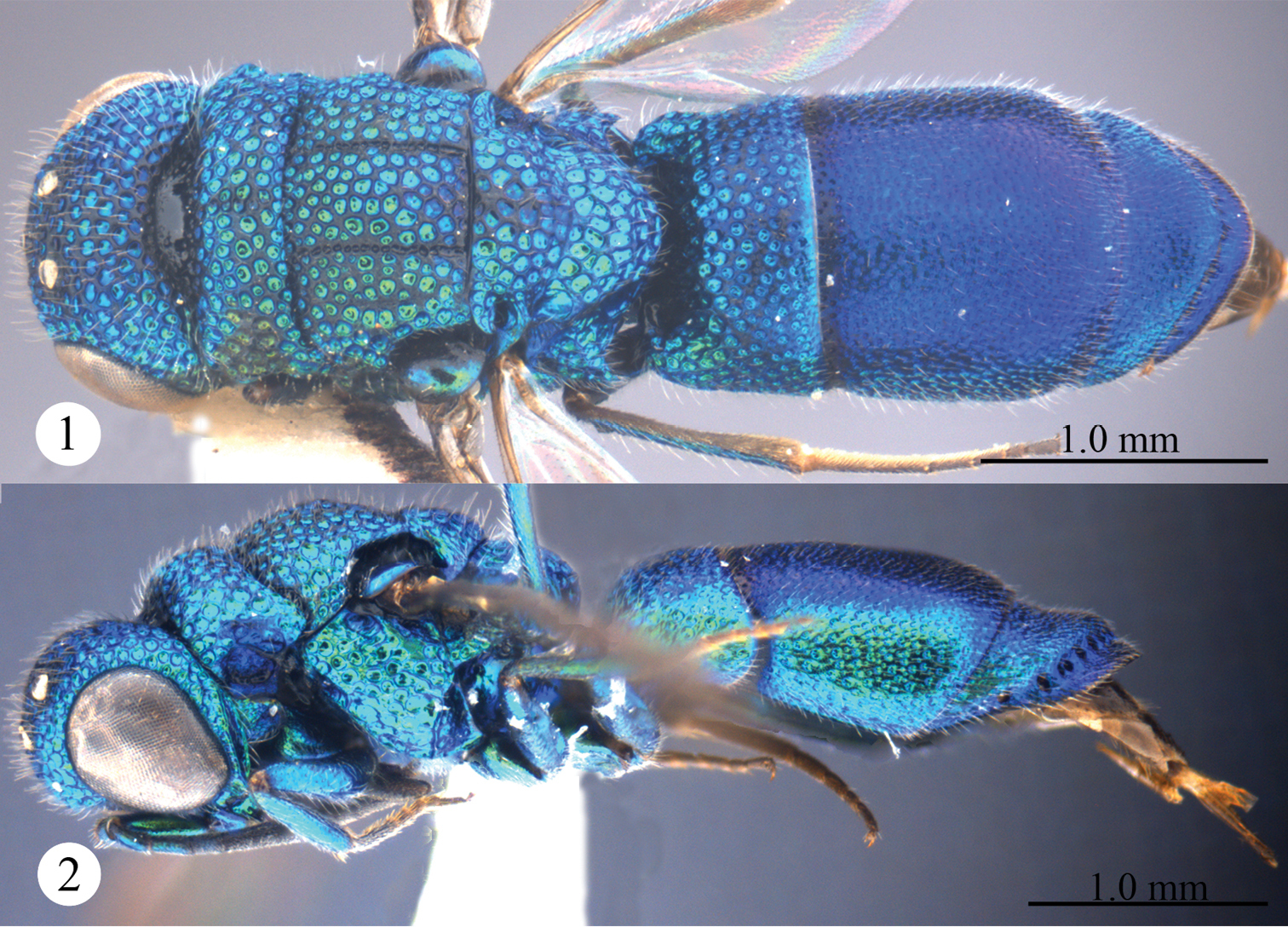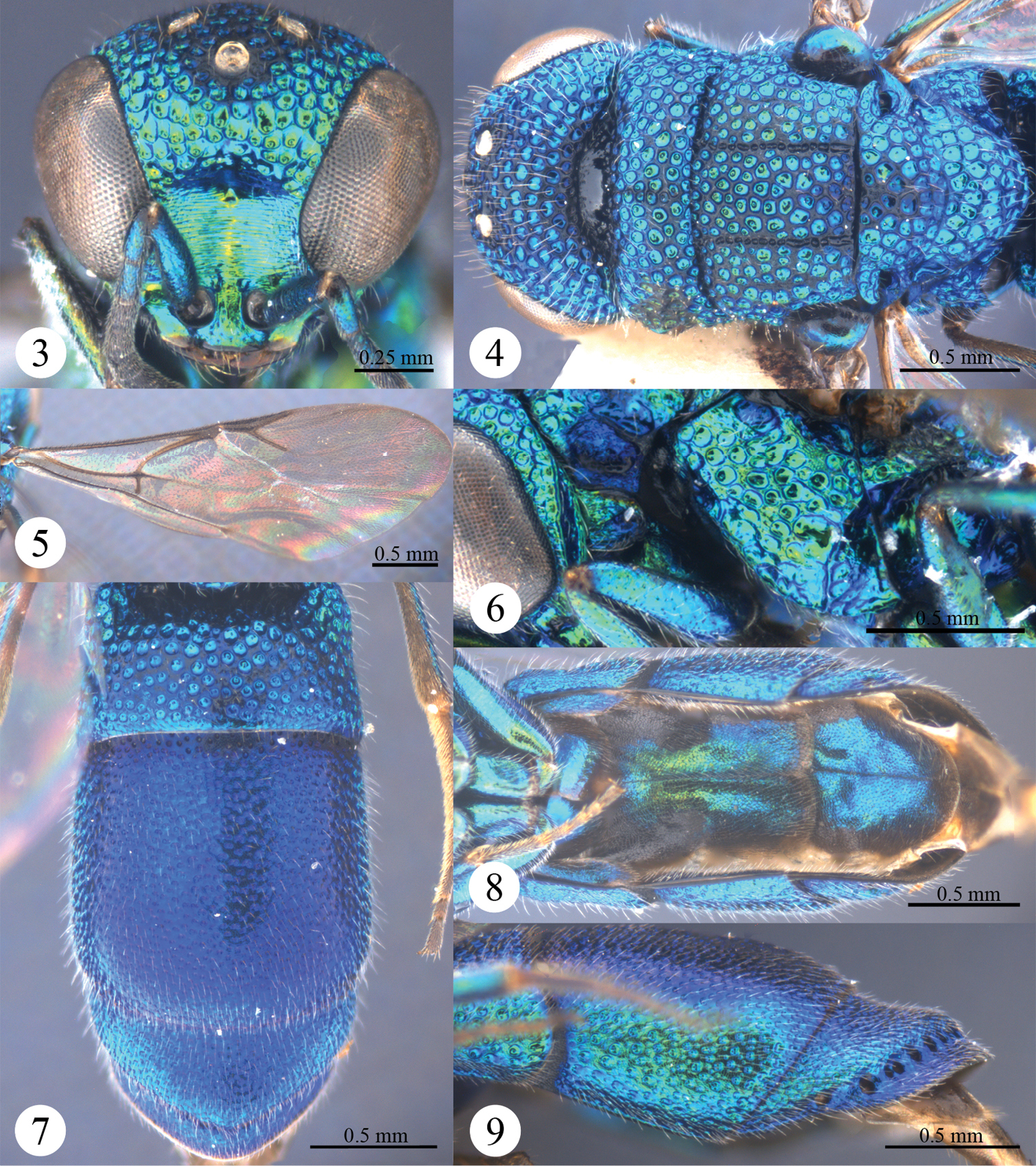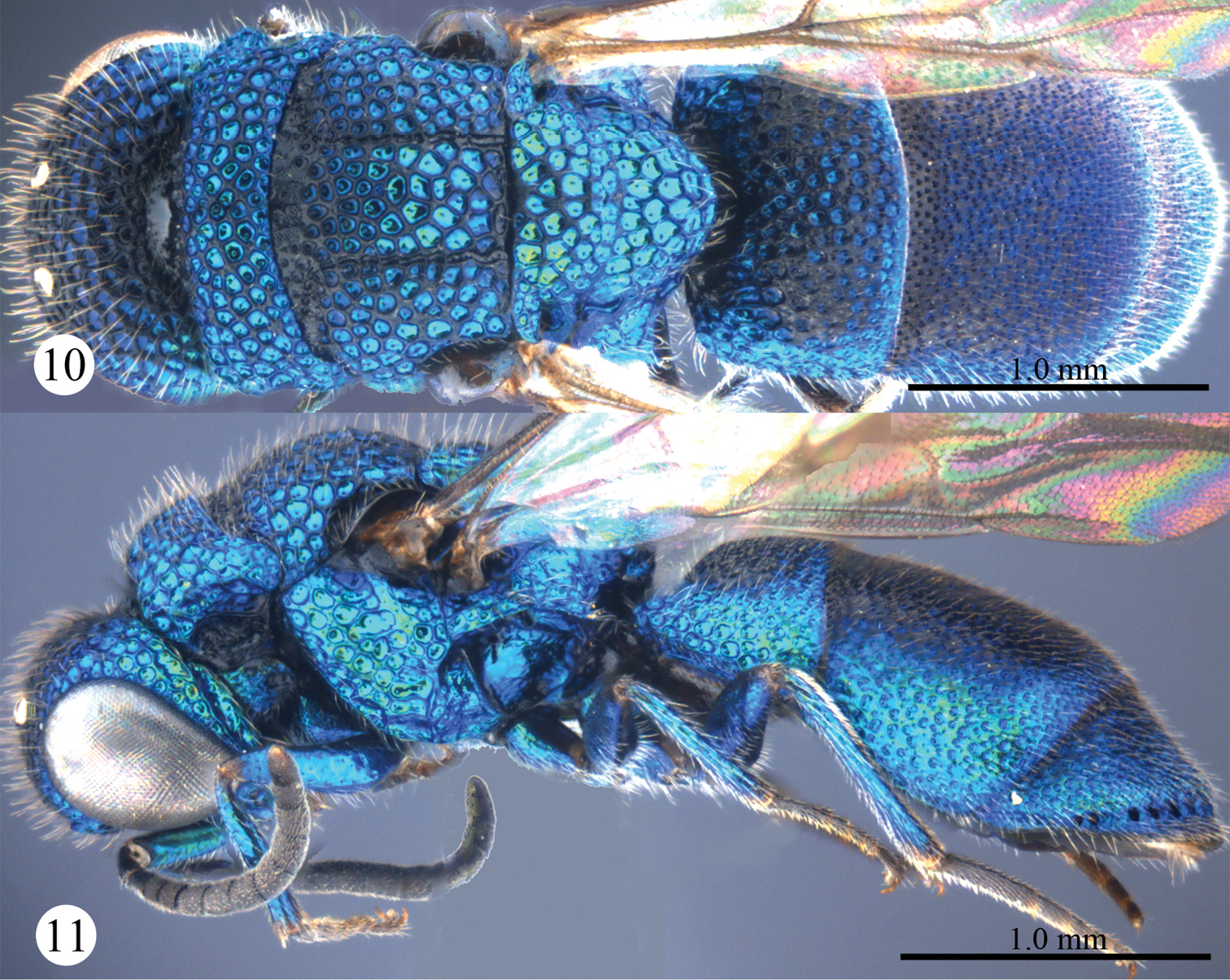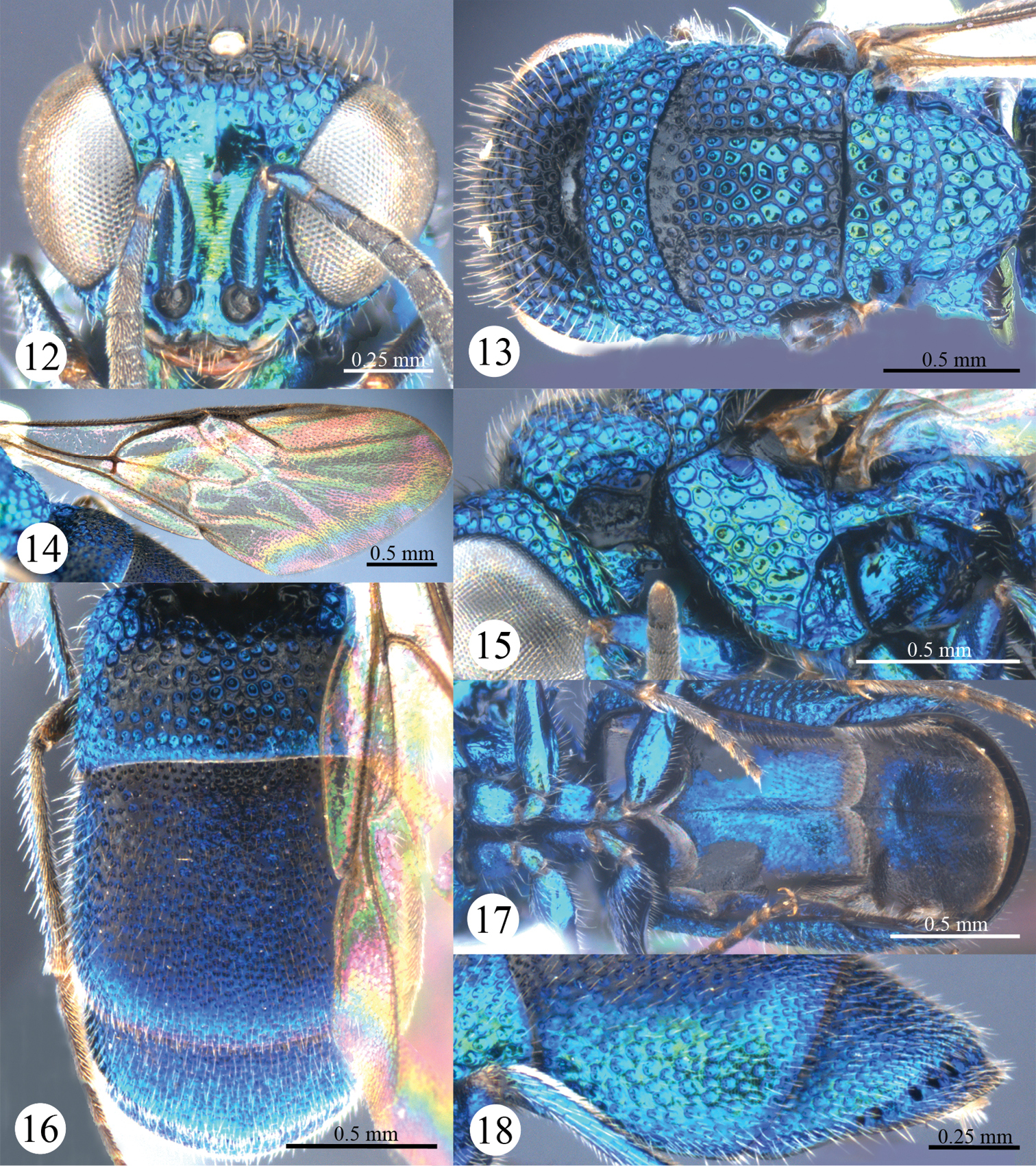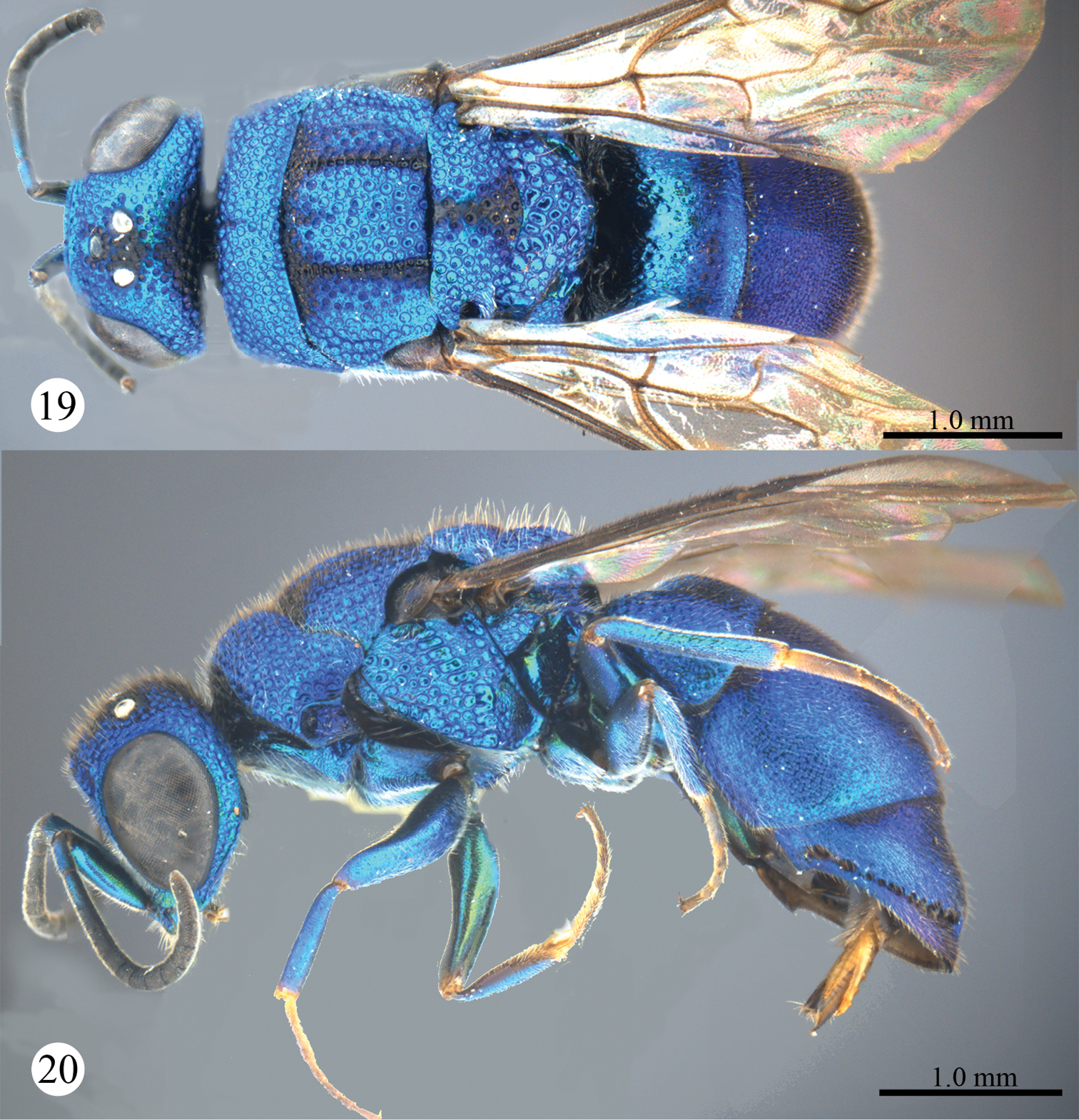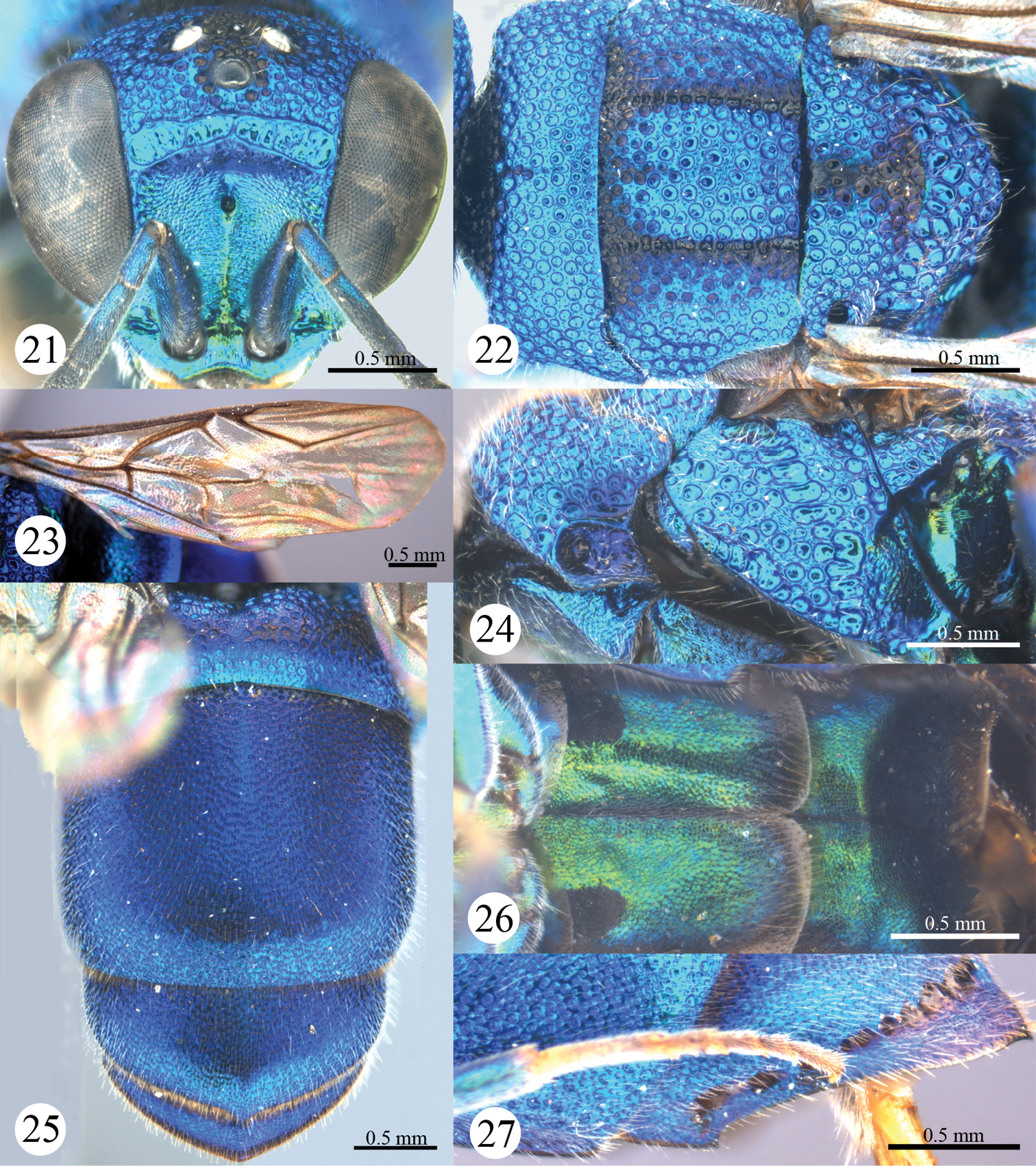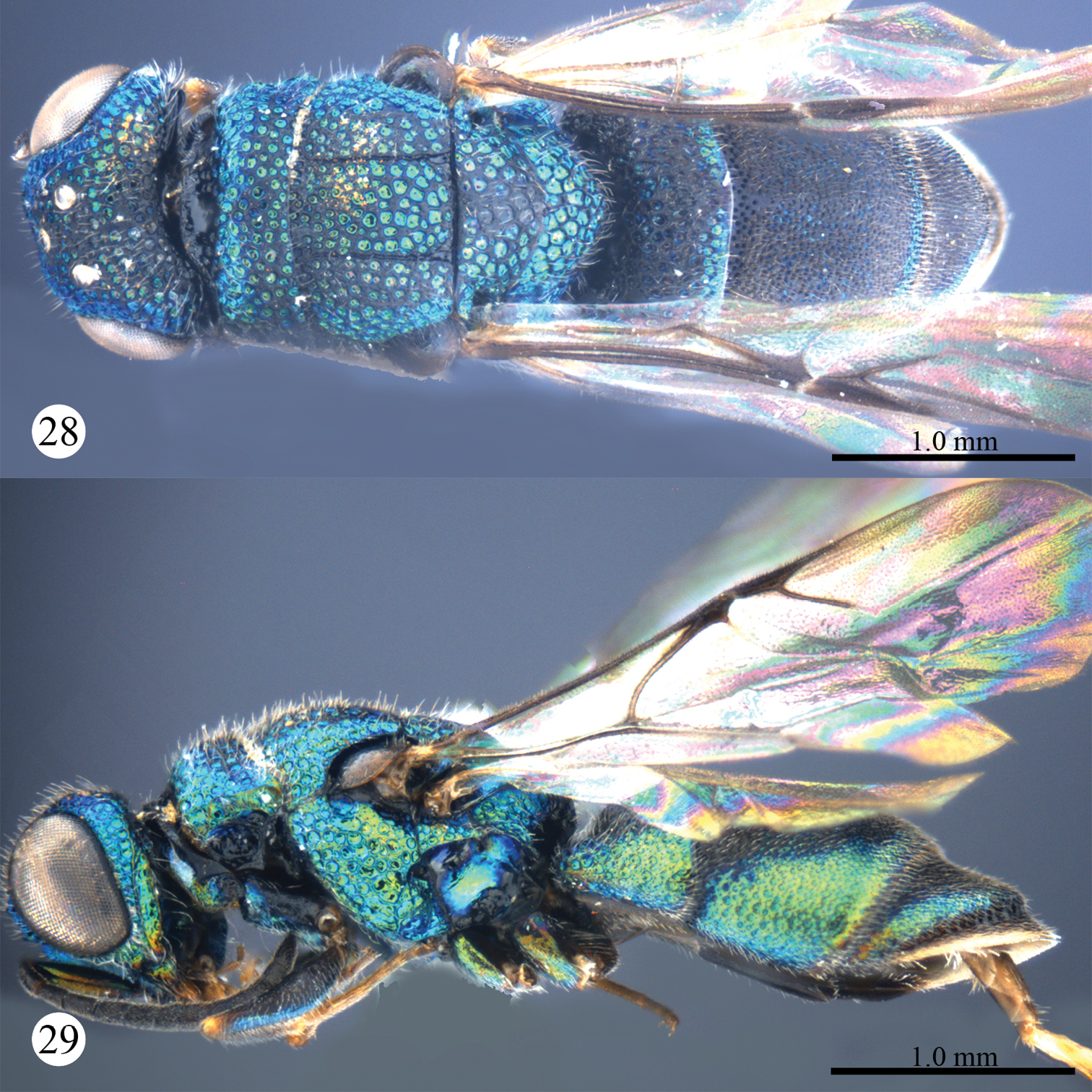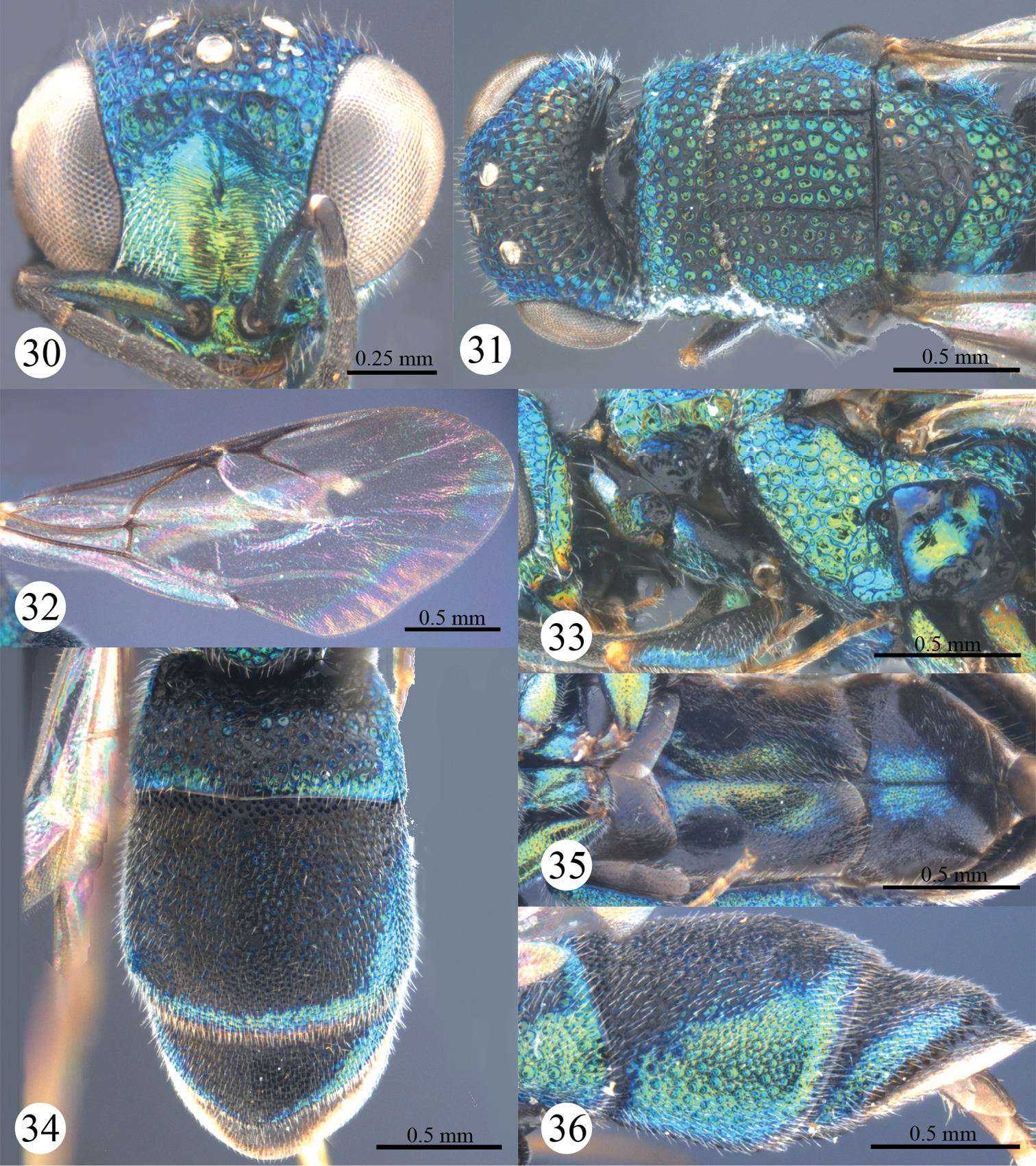






(C) 2014 Na-sen Wei. This is an open access article distributed under the terms of the Creative Commons Attribution License (CC BY 4.0), which permits unrestricted use, distribution, and reproduction in any medium, provided the original author and source are credited.
For reference, use of the paginated PDF or printed version of this article is recommended.
Citation: Wei N-s, Rosa P, Xu Z-f (2014) Contributions to the knowledge of the Chinese Primeuchroeus Linsenmaier, 1968 (Hymenoptera, Chrysididae), with a key to species. ZooKeys 373: 43–56. doi: 10.3897/zookeys.373.6556
The genus Primeuchroeus Linsenmaier, 1968 from China is revised and an illustrated identification key is produced for the first time. Three species are recorded from China, with one species, Primeuchroeus yongdaerianus Kim, new to China.
Chrysididae, Primeuchroeus, revision, new record, Oriental, China
Primeuchroeus Linsenmaier belongs to the tribe Chrysidini of the subfamily Chrysidinae (Kimsey & Bohart, 1991).
Presently 33 species of Primeuchroeus are known worldwide (
In China, before this study, only two species have been recorded from Taiwan by Tsuneki: Primeuchroeus crassiceps (Tsuneki, 1970) and Primeuchroeus kansitakuanus (Tsuneki, 1970). In this study, three species are recognized, with one new to China.
All specimens were examined and described under stereomicroscope (Olympus SZ61). All photos were taken with a digital camera (CoolSNAP) attached to a Zeiss Stemi 2000-CS stereomicroscope. Images were processed using Image-Pro Plus software.
Morphological terminology mainly follows
Abbreviations used in the descriptions as follows: F-I, F-II, F-III, etc. = flagellum I, flagellum II, flagellum III and so on; MOD = midocellar diameter; MS = malar space, the shortest distance between the base of mandible and the margin of compound eye; S-II spots = two oval dark spots on metasomal sternum II; TFC = transverse frontal carina; T-I, T-II, T-III, etc. = metasomal tergum I, tergum II, tergum III and so on.
All specimens are kept in the Hymenopteran Collection, South China Agricultural University, Guangzhou, China (SCAU) and the Shanghai Entomological Museum, Chinese Academy of Science, Shanghai, China (SEM).
http://species-id.net/wiki/Primeuchroeus
Scapal basin usually with fine transverse striae (Figs 3, 12, 21, 30). TFC often down-curved crescent, sometimes apparently double (Figs 21, 30), rarely flat or absent (Figs 3, 12). Subgenal area defined by carina. Mesopleuron without scrobal sulcus (Figs 6, 15, 24, 33). Forewing with Rs short and ending abruptly (Figs 5, 14, 32), or Rs long and nearly complete (Fig. 23). Lateral margin of T-III edentate (Figs 9, 18, 36), dentate, or convex basally (Fig. 27). Apex of T-III usually round (Figs 7, 16, 34) or obtusely angled medially (Fig. 25), rarely tridentate. Female T-IV with coarse transverse ridges.
| 1 | Forewing with Rs long, about two times as long as stigma, and bent sharply in the middle (Fig. 23); lateral margin of T-III convex, with a small tooth basally (Fig. 27) | Primeuchroeus kansitakuanus (Tsuneki) |
| – | Forewing with Rs short, about half as long as stigma, and ending obtusely (Figs 5, 14, 32); lateral margin of T-III nearly straight, without tooth basally (Figs 9, 18, 36) | 2 |
| 2 | TFC absent (Figs 3, 12); pronotum with an obtuse angle on each lateral margin (Figs 4, 13) | Primeuchroeus crassiceps (Tsuneki) |
| – | TFC distinct and double (Fig. 30); pronotum with an indistinct angle on each lateral margin (Fig. 31) | Primeuchroeus yongdaerianus Kim |
http://species-id.net/wiki/Primeuchroeus_crassiceps
Figs 1–181♀ (SCAU), Yunnan, Gaoligongshan National Nature Reserve (24°49'N, 98°46'E), 20–21.VII.2006, Jie Zeng, Juan-juan Ma & Bin Xiao leg., No. CP0038; 4♀♀+2♂♂ (SCAU), Yunnan, Gaoligongshan National Nature Reserve, Mailongxia (25°50'23"N, 98°51'23"E), 17.VIII.2005, Kai Wu leg., No. CP0039–0044.
Described after a female from Yunnan. Body length 4.3 mm (Figs 1, 2). Forewing length 3.1 mm. MS = 0.7 MOD. F-I 2.0× as long as wide.
Primeuchroeus crassiceps (Tsuneki, 1970), female from Yunnan. 1 Habitus, dorsal view 2 habitus, lateral view.
Head. Scapal basin deep and impunctate, with transverse striae and a round pit anteromedially (Fig. 3). F-I slightly longer than F-II (Fig. 3). TFC absent (Fig. 3).
Mesosoma. Pronotum with anterior declivity polished and impunctate between the two pits (Fig. 4); with an obtuse angle on each lateral margin (Fig. 4), with sublateral carina complete and lateral depression shallow (Fig. 6). Mesonotum with areolate punctures (Fig. 4). Mesopleuron without enlarged foveae along episternal sulcus (Fig. 6), without carina and projection (Fig. 6). Forewing with discoidal cell faint outwardly (Fig. 5); Rs short, 0.6 times as long as stigma, and ending obtusely (Fig. 5). Propodeal angle sharp and pointing backwards (Fig. 4).
Primeuchroeus crassiceps (Tsuneki, 1970), female from Yunnan. 3 Head, anterior view 4 head, pronotum, mesonotum, metanotum, and propodeum, dorsal view 5 forewing 6 pronotum, mesopleuron and metapleuron, lateral view 7 metasoma, dorsal view 8 metasoma, ventral view 9 T-II and T-III, lateral view.
Metasoma. T-I with sparser and considerably larger punctures than those on T-II and T-III (Fig. 7). S-II spots separated by 1.7 MOD (Fig. 8). T-III slightly bulging before pit row (Fig. 9); apex of T-III round, without transparent rim (Fig. 7); lateral margin of T-III nearly straight, without tooth (Fig. 9).
Colouration. Head and mesosoma metallic green, blackish along notauli. Mandible brown, with metallic green basally. Antenna black, with scape, pedicel and basal F-I metallic bluish-green. Tegula metallic bluish-green. Leg metallic bluish-green, with inner surface of tibia and tarsus brown. Metasoma metallic blue, with T-I metallic greenish-blue.
Male. Body length 4.3 mm (Figs 10, 11). Forewing length 3.1 mm. MS = 0.7 MOD. F-I 2.0× as long as wide. Subantennal space = 0.8 MOD. Differing from female as follows: vertex, mesosoma, T-I and T-II darker than those of female; forewing with discoidal cell more distinct than that of female (Fig. 14); apex of T-III rounder than that of female, without angle medially (Fig. 16).
Primeuchroeus crassiceps (Tsuneki, 1970), male from Yunnan. 10 Habitus, dorsal view 11 habitus, lateral view.
Primeuchroeus crassiceps (Tsuneki, 1970), male from Yunnan. 12 Head, anterior view 13 head, pronotum, mesonotum, metanotum, and propodeum, dorsal view 14 forewing 15 pronotum, mesopleuron and metapleuron, lateral view 16 metasoma, dorsal view 17 metasoma, ventral view 18 T-II and T-III, lateral view.
Variation. Females (n = 5). Body length 3.5–4.4 mm. Forewing length 3.0–3.4 mm. Rs 0.5–0.6 times as long as stigma. Metasoma with purple tints; F-I subequal to F-II. Males (n = 2). Body length 3.5–4.3 mm. Forewing length 3.0–3.1 mm.
F-I slightly longer than F-II. TFC absent. Pronotum with an obtuse angle on each lateral margin. Forewing with Rs short, 0.6 times as long as stigma, ending obtusely. Lateral margin of T-III nearly straight, without tooth.
China (Taiwan, Yunnan).
Unknown. Collected in July and August.
According to
http://species-id.net/wiki/Primeuchroeus_kansitakuanus
Figs 19–271♀ (SCAU), Zhejiang, Lin’an, Mt. Qingliangfeng (30°04'N, 118°52'E), 9.VIII.2005, Hong-ying Zhang leg., No. 200603255; 1♀ (SEM) Fujian, Da’an (27°51'12.80"N, 117°54'24.42"E), 1.VII.1959, Gen-tao Jin & Yang-ming Lin leg., No. 34022850; 1♀ (SCAU), Hubei, Jingmen, Jingshan (31°1'1'N, 113°78'10"E), 15.VII.2009, Yuan Ye leg., No. CP0029; 13♀♀ (SCAU), Hunan, Mt. Huping, Shinianzigou (29°55'38"N, 118°48'48"E), 9.VII.2009, Ya-li Tang leg., No. CP0002–0014; 4♀♀ (SCAU), Hunan, Mt. Huping, Shinianzigou, 9.VII.2009, Shi-hong Wang leg., No. CP0015–0018; 1♀ (SCAU), Hunan, Mt. Huping, Zongfeng (29°55'N, 118°48'E), 9.VII.2009, Shi-hong Wang leg., No. CP0019; 1♀ (SCAU), Hunan, Mt. Huping, Shuawu village (29°55'N, 118°48'E), 10.VII.2009, Li Ma leg., No. CP0020; 1♀ (SCAU), Hunan, Huaihua (27°33'17"N, 109°59'53"E), VIII.2004, Jian-hua Zhou leg., No. CP0021; 2♀♀ (SCAU), Guangzhou, Wangzishan Forest Park (23°34'49"N, 113°13'21"E), 20.V.2006, Ju-jian Chen & Zai-fu Xu leg., No. CP0030, 0031; 4♀♀ (SCAU), Guangzhou, Liuxihe Forest Park (23°44'31"N, 113°47'0"E), 20.VI.2004, Zai-fu Xu leg., No. CP0032–0035; 2♀♀ (SCAU), Guangdong, Chebaling National Nature Reserve (24°43'N, 114°14'E), 22–28.VII.2008, Zai-fu Xu leg., No. CP0036, 0037; 1♀ (SCAU), Hainan, Mt. Wuzhi (18°51'N, 109°39'E), 15–16.V.2008, Jing-xian Liu leg., No. 200800155; 1♀ (SCAU), Guizhou, Tianzhu (26°54'32"N, 109°12'22"E), VIII.2009, Yang-wen Wang leg., No. CP0001; 2♀♀ (SCAU), Guizhou, Mayang River, Dahe Dam (28°38'12"N, 108°17'13"E), 27.IX–2.X.2007, Jie-min Yao leg., No. CP0027, 0028; 3♀♀ (SCAU), Yunnan, Jinggu, Yunhai Reserve (23°29'37"N, 100°42'39"E), 3.X.2004, Jing-xian Liu leg., No. CP0022–0024; 1♀ (SCAU), Yunnan, Yingjiang, Taiping village (24°39'29"N, 97°51'9"E), 15.VIII.2005, Qiang Li leg., No. CP0025; 1♀ (SCAU), Yunnan, Chenggong, Luoyang (24°55'35'N, 102°48'37"E), 8–19.VIII.2006, Qiang Li leg., No. CP0026.
Described after a female from Guizhou. Body length 7.0 mm (Figs 19, 20). Forewing length 4.6 mm. MS = 0.6 MOD. F-I 3.0× as long as wide.
Primeuchroeus kansitakuanus (Tsuneki, 1970), female from Guizhou. 19 Habitus, dorsal view 20 habitus, lateral view.
Head. Scapal basin deep, with transverse striae and punctures, with a round pit anteromedially (Fig. 21). F-I dinstinctly longer than F-II (Fig. 21). TFC distinct and double (Fig. 21).
Primeuchroeus kansitakuanus (Tsuneki, 1970), female from Guizhou. 21 Head, anterior view 22 pronotum, mesonotum, metanotum, and propodeum, dorsal view 23 forewing 24 pronotum, mesopleuron and metapleuron, lateral view 25 metasoma, dorsal view 26 metasoma, ventral view 27 T-II and T-III, lateral view.
Mesosoma. Pronotum with anterior declivity polished and impunctate between the two pits (Fig. 22); without angle on each lateral margin (Fig. 22), without sublateral carina, but with lateral depression deep (Fig. 24). Mesonotum with round punctures (Fig. 22). Mesopleuron with enlarged foveae along episternal sulcus (Fig. 24), with scrobal carina and a very small projection near scrobe (Fig. 24). Forewing with discoidal cell distinct (Fig. 23); Rs long, 2.4 times as long as stigma, sharply bent in the middle and nearly complete (Fig. 23). Propodeal angle sharp and pointing backwards.
Metasoma. T-I with sparser and considerably larger punctures than those on T-II and T-III (Fig. 25). S-II spots separated by 3.0 MOD (Fig. 26). T-III not bulging before pit row (Fig. 27); apex of T-III obtusely angled medially, without transparent rim (Fig. 25); lateral margin of T-III convex, with a small tooth basally (Fig. 27).
Colouration. Face metallic green. Mandible brown, with metallic green basally. Antenna black, with scape, pedicel and basal F-I metallic bluish-green. Vertex and mesosoma metallic bluish-green, with ocellar triangle, anterior part of pronotum, notauli, and metanotum black. Tegula blackish-brown. Leg metallic bluish-green, with tarsus testaceous. Metasoma metallic bluish-green.
Variation. Females (n = 40). Body length 5.0–7.0 mm. Forewing length 3.4–4.6 mm. Rs 2.0–2.4 times as long as stigma.
Male. Unknown.
F-I distinctly longer than F-II. TFC distinct and double. Forewing with Rs long, 2.0–2.4 times as long as stigma, and bent sharply in the middle. Lateral margin of T-III convex, with a small tooth basally.
China (Zhejiang, Hubei, Hunan, Taiwan, Fujian, Guangdong, Hainan, Guizhou, Yunnan); Vietnam; Malaysia.
Unknown. Collected from May to October.
According to
http://species-id.net/wiki/Primeuchroeus_yongdaerianus
Figs 28–364♀♀ (SCAU), Yunnan, Gaoligongshan National Nature Reserve (24°49'N, 98°46'E), 20–21.VII.2006, Jie Zeng, Juan-juan Ma & Bin Xiao leg., No. CP0045–0048; 8♀♀ (SCAU), Yunnan, Gaoligongshan National Nature Reserve, Mailongxia (25°50'23"N, 98°51'23"E), 17.VIII.2005, Kai Wu leg., No. CP0049–0056.
Described after a female from Yunnan. Body length 3.1 mm (Figs 28, 29). Forewing length 2.5 mm. MS =1.2 MOD. F-I 2.5× as long as wide.
Primeuchroeus yongdaerianus Kim, 2013, female from Yunnan. 28 Habitus, dorsal view 29 habitus, lateral view.
Head. Scapal basin deep and impunctate, with transverse striae and an elongate pit anteromedially (Fig. 30). F-I slightly longer than F-II (Fig. 30). TFC distinct and double (Fig. 30).
Primeuchroeus yongdaerianus Kim, 2013, female from Yunnan. 30 Head, anterior view 31 head, pronotum, mesonotum, metanotum, and propodeum, dorsal view 32 forewing 33 pronotum, mesopleuron and metapleuron, lateral view 34 metasoma, dorsal view 35 metasoma, ventral view 36 T-II and T-III, lateral view.
Mesosoma. Pronotum with anterior declivity polished and impunctate between two pits (Fig. 31); with an indistinct angle on each lateral margin (Fig. 31), with sublateral carina incomplete, and with lateral depression shallow (Fig. 33). Mesonotum with areolate punctures (Fig. 31). Mesopleuron without enlarged foveae along episternal sulcus (Fig. 33), without scrobal carina and projection (Fig. 33). Forewing with discoidal cell faint outwardly (Fig. 32); Rs short, 0.6 times as long as stigma, and ending obtusely (Fig. 32). Propodeal angle sharp and pointing backwards (Fig. 31).
Metasoma. T-I with sparser and considerably larger punctures than those on T-II and T-III (Fig. 34). S-II spots separated by 2.3 MOD (Fig. 35). T-III slightly bulging before pit row (Fig. 36); apex of T-III round, with broad testaceous transparent rim (Fig. 34); lateral margin of T-III nearly straight, without tooth (Fig. 36).
Colouration. Face metallic green, with yellow reflections. Mandible brown, with metallic green basally. Antenna black, with scape metallic green. Vertex, pronotum, mesonotum, and metanotum metallic bluish-green. with black colour. Tegula blackish-brown, with metallic blue hints. Leg with coxa and femur metallic green; tibia mostly brown, with slight metallic reflections; tarsus brown. Metasoma mostly black, with metallic green reflections posteriorly and laterally on each segment.
Variation. Females (n = 12). Body length 2.6–4.1 mm. Forewing length 2.4–3.1 mm. F-I subequal to F-II. Rs 0.6–0.7 times as long as stigma.
Male. No available specimens for this study.
TFC distinct and double. Forewing with Rs short, 0.6 times as long as stigma, and ending obtusely. Lateral margin of T-III nearly straight, without tooth.
China (Yunnan); Korea.
Unknown. Collected in July and August.
According to
Many thanks to Assoc. Prof. Hai-sheng Yin and Ms Li Dai of Shanghai Entomological Museum (Shanghai, China) and Dr. Frank Koch of Museum für Naturkunde (Berlin, Germany) for their kind help during the first author’s visit. We appreciate the kind help of Assoc. Prof. Geoff Allen of University of Tasmania (Hobart, Australia) and Mr. David Baldock (Milford Surrey, England) in improving the manuscript English. This study was supported by the National Basic Research Program of China (No. 2013CB127600) and the National Natural Science Foundation of China (30770265).
